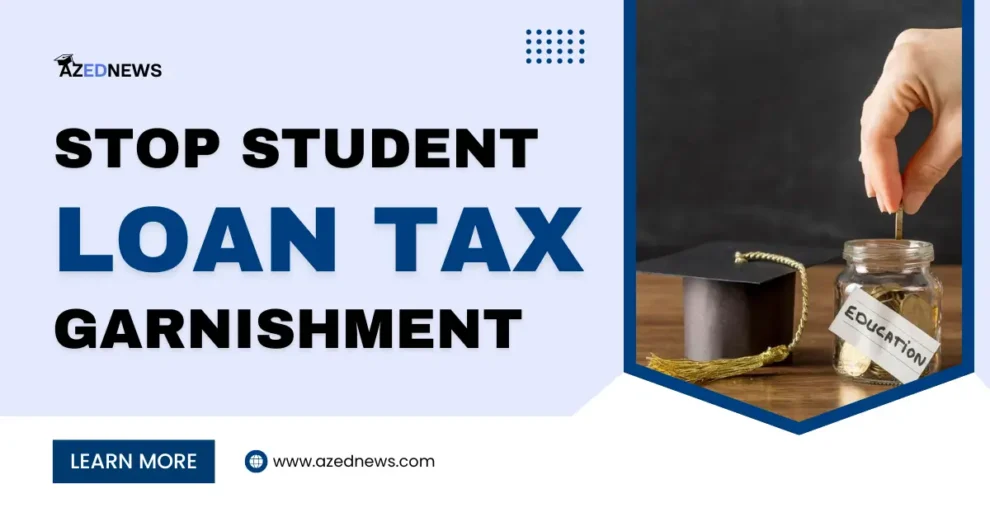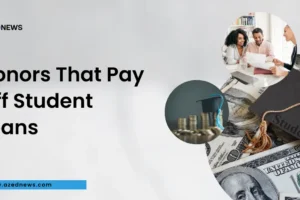Are you searching article on how to stop student loan tax garnishment? then you are on the right place. The government may withhold your tax refunds in order to partially offset your debt if you fall behind on a federal student loan. The administration has put a stop to this program as well as other data collection initiatives.
Table of Contents
Withheld tax refunds will not be permitted under the Fresh Start program for borrowers with prior student loan defaults until at least September 2024. Additionally, when payments start up again, borrowers won’t go into default again.
From October 1, 2023, to September 30, 2024, there will be a 12-month student loan on-ramp from the White House. During this time, any incomplete, missed, or late payments will not result in delinquency or default.
So, today we are going to discuss the student loan tax garnishment in detail in the U.S.
Key Takeaways:
- Withheld tax refunds will not be permitted under the Fresh Start program for borrowers with prior student loan defaults until at least September 2024.
- Tax garnishment typically doesn’t happen until after your student loans are in default, which can happen if you haven’t made a payment in at least 270 days.
- The U.S. Department of Education (ED) has a temporary program called Fresh Start that provides additional benefits to borrowers who have federal student loans.
- The Treasury Department will give you a check or direct deposit for any residual refund after deducting the offset amount.
- For student loans that are not provided by the federal government or that are privately owned, the creditor lacks the right to garnish wages in a particular way.
- Take immediate action because you only have 30 days from the date you receive the notice of intent to garnish to work out a repayment plan.
- To stop student loan garnishment, students should repay their education loans, combine their education debts, and more.
- The Fresh Start program is the best option to get out of default on federal student loans and prevent student loan tax garnishment if you have them.
- Some ways to stop student loan tax garnishment are by paying the remaining amount in full and discussing the terms of repayment.
- Students can protect their spouse’s share of the federal tax refund by submitting an injured spouse allocation form, or IRS Form 8379.
What is student loan tax garnishment?
When your employer is required by the federal government to deduct money from your paycheck in order to pay off outstanding student loan debt, this is known as student loan garnishment.
Your loan servicer receives the garnished funds in order to settle your delinquent student debts. You may have up to 15% of your income withheld until you repay or get your loans out of default.
Wage garnishment typically doesn’t happen until after your student loans are in default, which can happen if you haven’t made a payment in at least 270 days. After ninety days of nonpayment on federal loans, your loan servicer may report your account as delinquent to the credit bureaus, which might negatively impact your credit.
The whole amount owed on your government or private loans becomes immediately due when they default. You have three options with federal loans: you can consolidate, rehabilitate, or pay off the entire balance.
The government has the right to withhold tax refunds or garnish your earnings if you don’t take care of the issue right away.
Private loans, on the other hand, may default with just one late payment. Your salary may also be garnished by private student loan lenders, but only after they file a lawsuit and obtain a judgment from the court.
What is the Fresh Start program?
The U.S. Department of Education (ED) has a temporary program called Fresh Start that provides additional benefits to borrowers who have federal student loans that have fallen into default. The end of Fresh Start is September 30, 2024.
You get certain benefits automatically with Fresh Start, such as your ability to apply for federal student loans and grants again. To take advantage of Fresh Start’s full benefits and avoid default, however, you must take action.
What are the benefits of a fresh start program?
1. Access to federal student aid:
Now that you’re qualified for Fresh Start, you can once again apply for federal student aid. Applying for federal loans and grants is possible if you wish to resume your education. Completing an incomplete degree, could help you pay back your loans more easily.
2. Stopped collections:
During Fresh Start, you maintain the collection relief that you received during the COVID-19 payment stop. The following collection relief will still be provided to you:
- There will be no deductions made from tax refunds or child tax credits.
- There won’t be a wage garnishment.
- There will be no deductions from Social Security benefits, including disability benefits.
- There won’t be any calls for collection.
3. Become eligible for other government loans:
Applicants who are listed as “in default” in the government credit reporting system will often be turned down by lenders, particularly for government-backed loans. You might be able to apply for mortgages and other government-backed loans with this Fresh Start perk.
4. Ability to rehabilitate loans:
A loan can usually only be rehabilitated once. However, Fresh Start will not be considered your one and only opportunity to repay your loan(s). Let’s take a situation where you have never rehabilitated a debt.
Your loan goes into default again after using Fresh Start to bring it out of default. You will still be able to rehabilitate your loan in this situation.
How does student loan tax garnishment work?
The Treasury Offset Program (TOP), a government-run initiative, is the mechanism via which student loan taxes are garnished.
Through the program, the government can seize certain federal payments, such as Social Security benefits or tax returns, in order to recover unpaid obligations to both federal and state government entities.
The Treasury Department may send you a letter informing you that your tax refund could be taken if you still owe money on your student loans.
What will happen after you get tax offset notice?
The Treasury Department may send you a tax offset notice that details the amount of your tax refund that was originally scheduled to be refunded and the amount that will be deducted to settle any outstanding federal debts, including defaulted student loans.
To halt the offset of the tax refund, you might ask for a hearing. The notification explains how to file a request for a hearing.
The Treasury Department will give you a check or direct deposit for any residual refund after deducting the offset amount.
How can I avoid Treasury offsets after my fresh start is over?
A notification of intent to offset notifying you that the offset is slated to start in 65 days will be sent to your last known address prior to the offset starting.
Offsets will remain until your debt is settled in full or the default status is cleared. The notice may only be delivered once.
If you make payments within the allotted 65 days, you could be eligible to avoid an offset. You may still be able to suspend offset after the 65-day period has passed if you sign a rehabilitation agreement and make the first five of the nine payments that are needed.
You are entitled to a review of your objection if you have one against the debt. If you are successful, the amount being offset may be lowered, or your tax refund and other government payments will not be offset.
Your tax refund and other government payments will be deducted if you are not successful.
Is tax garnishment applied to private student loans?
Regarding student loans that are not provided by the federal government or that are privately owned, the creditor lacks the right to garnish wages in a particular way.
The creditor must file a lawsuit against you in order to get a judgment, and after the judgment is obtained, it must be submitted to your employer along with a court order detailing the garnishment.
Depending on your state, they may garnish a different amount from you. Up to 25% of your disposable income typically calculated as 25% of your earnings after 30 times the minimum wage, or $217.50 may be garnished by creditors in certain states.
Some forms of income, though, are not subject to garnishment. Private student loan garnishments do not apply to Social Security benefits, child support, alimony, disability benefits, pension income, income from individual retirement accounts (IRAs), 401(k)s, and other retirement monies.
How to stop student loan garnishment?
Get in touch with your loan servicer as soon as possible to discuss your alternatives for repayment if you’re behind on your payments but haven’t yet entered default.
Take immediate action because you only have 30 days from the date you receive the notice of intent to garnish to work out a repayment plan and send the necessary paperwork and initial payment to the U.S. Department of Education (ED).
There aren’t many ways to get out of default and avoid having your student loans garnished after they go into default. Here are three ways to prevent pay garnishment in the interim.
1. Repay Your Education Loans:
One choice is to work with your federal student loan servicer to enter into a voluntary student debt rehabilitation agreement.
If you follow the terms of the agreement and make nine consecutive on-time monthly payments equal to 15% of your monthly discretionary income, you might be able to get your loans back in good standing.
It is imperative that you provide ED with your initial payment and any necessary information within 30 days of the garnishment notice date. Your options for rehabilitation may be limited if your loans are being serviced by a private lender.
Nevertheless, it’s a good idea to get in touch with your lender or the designated collection agency to work out a payback schedule or a reduced debt payoff amount. Students can reach out to donors that pay off student loans in situations like these.
2. Combine Your Education Debts:
Combining your federal debts into a direct loan consolidation, which offers two alternatives, is another way to get them out of default:
- Prior to combining, make three timely monthly payments toward the debt. After that, your loan servicer will determine an appropriate payment amount.
- To make the direct loan consolidation installments, forgo the three payments and sign up for an income-driven repayment (IDR) plan. Your servicer caps the monthly percentage paid under an IDR plan at a particular proportion of your income.
Recall that a student loan consolidation does not erase a default from your credit report; only a rehabilitation plan can.
3. Make a hearing request:
In the event that the wage garnishment would put you in severe financial hardship, you also have the opportunity to contest it. If, following an involuntary unemployed spell, you have been employed for less than a year, you may also initiate a dispute.
You have 30 days from the date of the wage garnishment notification to file a written request for a hearing. After submitting your request, you need to hear back on the garnishment within sixty days.
If the decision is in your favor, you might not have any garnishment at all or only have a smaller withholding percentage. On the other hand, if your challenge is rejected by a hearing judgment, you will be responsible for the 15% wage garnishment.
4. Pay Off Your Whole Amount Due on Student Loans:
Depending on your total outstanding loan sum, paying off your student loans in full at once may be challenging, but it’s a wise move for a secure financial future.
If you have emergency funds, you could use them. If not, you might be able to receive help from a reliable friend or relative.
Even though asking a loved one for money can be difficult, it’s preferable to defaulting on a student loan and running the danger of having your earnings garnished.
If you use this method, settle on terms for payments up front, including interest, to help prevent disputes later.
How do students know if the tax refund has been taken to pay off student loan debt?
You won’t get a summons since federal student loan garnishments don’t need to go through the legal system. Without going through the legal system, the Department of Education expedites garnishments through a unique administrative procedure.
You will get a notice from the Treasury Offset Program (TOP) sixty days prior to the date on which your tax return will be garnished. You will receive an explanation of some of your rights with this notification.
You will be informed in the notification that you may undertake the following activities prior to having your tax return garnished:
- Dispute the debt
- Request copies of agency records
- Request an administrative review of your total debt amount
- Make an acceptable repayment plan
How can students dispute student loan debt?
If you can stop the tax garnishment on your student loans, it will be worth the time and effort to dispute the debt.
First, compile all of your documentation and contrast the debt amount and repayments with those on your credit report, your payment history, and the account details on the website of your student loan servicer.
Make sure there are no name errors, typos, or records of relatives by double-checking your name and address information. It is advisable to examine your credit reports for discrepancies resulting from identity theft.
Write down any mistakes you see after organizing and summarizing them. List the essential details. If there are any inaccuracies in the credit reporting of your student loan, let your lenders and loan servicers know, ideally in writing.
How can i Stop Student Loan Tax Garnishment?
The Fresh Start program is the best option to get out of default on federal student loans and prevent student loan tax garnishment if you have them. Here are some further strategies to prevent tax garnishments:
1. Pay the remaining amount in full:
Paying off your student loans in full is the easiest way to prevent tax garnishment. Even while this may not be possible for everyone, it releases you from any further loan-related debt and ends the garnishment procedure right away.
2. Utilize to combine:
You may want to consider consolidating your student loans. During this process, several federal student loans are combined into a single new loan with a new repayment period.
You can prevent tax garnishment and get your loans out of default in as short as three months by combining. However, since consolidation can take some time to process, you must move promptly.
Furthermore, you run the risk of going back into default on your student loans if you find it difficult to make your new payment after you’ve consolidated them.
3. Discuss your terms of repayment:
One way to get your student loans out of default is to negotiate your repayment arrangements through a procedure called loan rehabilitation.
You pay your student loan servicer back over a certain number of consecutive payments under the terms of a loan rehabilitation agreement. The majority of loans have payment levels that are determined by your income.
Your debt is taken out of default by the lender as soon as you make the last payment. There will be no more collection efforts, including garnishments of tax refunds.
After that, you can either apply for an income-driven repayment plan or start making regular payments again.
Will the spouse’s refund be garnished too?
If you are married and file taxes together, students may be able to protect their spouse’s share of the federal tax refund by submitting an injured spouse allocation form or IRS Form 8379.
They can provide this form when they file their taxes or later if they weren’t aware of the offset at the time. Students may have as long as three years from the due date of their original return to submit this paperwork.
Frequently Asked Questions
1. Can private student loans be garnished by taxes?
Only federal student loans and other debts owed to federal, state, and local authorities are subject to tax garnishment. State regulations may differ, but generally speaking, private student loan lenders are not allowed to withhold your tax refunds or other federal payments.
2. When does the Fresh Start program end?
The current timeline for the Fresh Start program is September 2024–September 2024. Before September 30, 2024, get in touch with your loan servicer to ask to be included in the Fresh Start program. Your loan will be moved to a new loan servicer and pulled out of default as part of this procedure.
3. How much of a student loan can the IRS seize?
In order to pay back your federal student loans, the federal government is legally allowed to seize up to 15% of your discretionary income and 100% of your tax return.
4. What’s the best strategy to keep taxes on student loans from being garnished?
Remaining out of default on your loans is the strongest defense against tax garnishment related to student loans. By paying as promised, looking into income-driven repayment programs, or requesting deferment or forbearance while facing financial difficulties, you can prevent default.
5. If I’ve already received a garnishment letter, is there anything I can do?
Yes. You can still get in touch with your loan servicer and work out a payment plan even if you’ve gotten a garnishment letter. Thirty days prior to the start of garnishment, garnishment letters are sent out.
Conclusion
Although it could be challenging to fit student loans into your budget, most lenders are fairly understanding if a borrower requires an alternative payment schedule.
Working with your lender or requesting a forbearance is always preferable to defaulting on your debt and running the danger of having your wages garnished.
One of the best strategies to avoid wage garnishment and work toward getting your student loans out of default is to consolidate or rehab your debt.
Once your debts are stabilized, develop sound financial practices to maintain your credit and student loan balances, such as consistently making on-time payments.












Add Comment